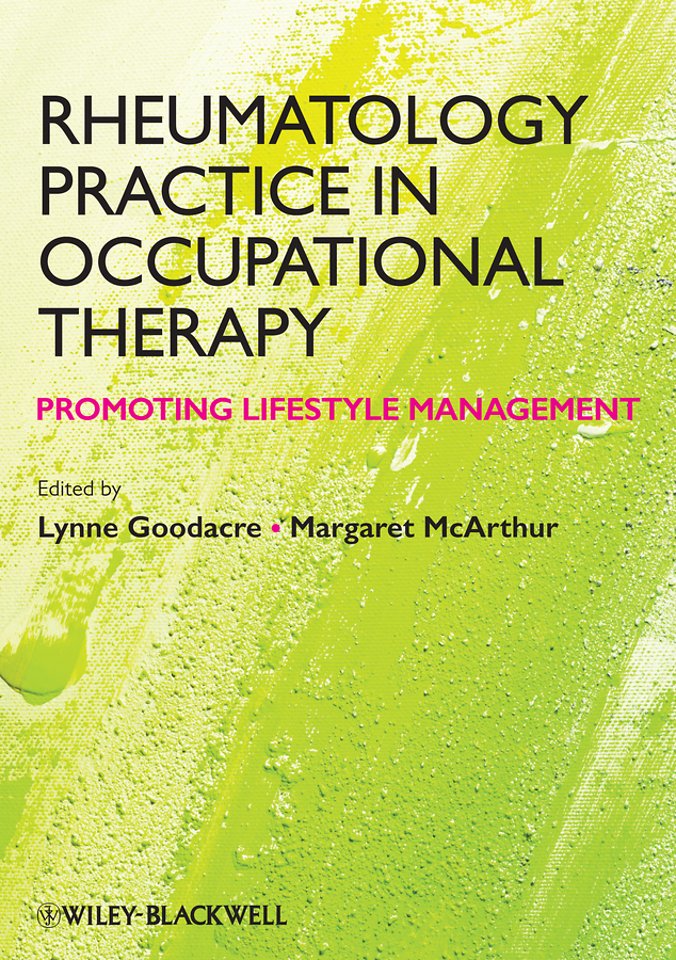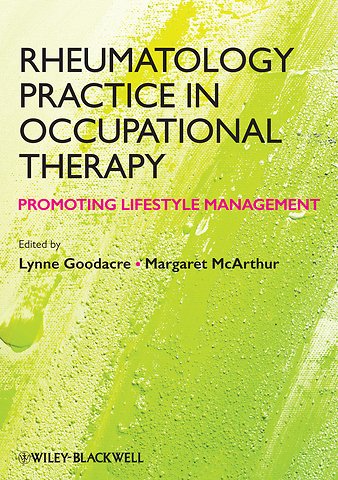Rheumatology Practice in Occupational Therapy – Promoting Lifestyle Management
Promoting Lifestyle Management
Samenvatting
Rheumatology Practice in Occupational Therapy is a valuable new handbook focusing on the core area of rheumatology. It provides practical guidance to help occupational therapists treat and manage rheumatic disease in both clinical and community settings and emphasizes a contemporary client–centred approach as a fundamental requirement of effective and rewarding OT practice. Drawing upon personal, clinical and theoretical perspectives, it equips the reader with an understanding not only of relevant practical skills but of the clinical reasoning required to modify and apply these skills to the needs of individual people.
Specificaties
Inhoudsopgave
<p>Preface xi</p>
<p>1 Living with a rheumatic disease: the personal perspective 1<br /> Lynne Goodacre and Margaret McArthur</p>
<p>1.1 Introduction 1</p>
<p>1.2 Living with a rheumatic condition 3</p>
<p>1.3 Developing new skills and learning 9</p>
<p>1.4 Summary 12</p>
<p>2 Living with rheumatic diseases: the theoretical perspective 13<br /> Margaret McArthur and Lynne Goodacre</p>
<p>2.1 Introduction 13</p>
<p>2.2 Understanding and being understood 13</p>
<p>2.3 The impact of a rheumatic condition on a person s sense of self 17</p>
<p>2.4 The experience of living with a rheumatic condition 23</p>
<p>2.5 Acknowledge the loss, promote the gain 25</p>
<p>3 Understanding rheumatic diseases: the occupational therapy perspective 29<br /> Margaret McArthur</p>
<p>3.1 The centrality of occupation 29</p>
<p>3.2 Occupational potential 30</p>
<p>3.3 Occupational science 30</p>
<p>3.4 Understanding need 31</p>
<p>3.5 Occupational identity 33</p>
<p>3.6 Occupational adaptation 34</p>
<p>3.7 Occupational balance 34nts</p>
<p>3.8 Occupational gain 35</p>
<p>3.9 Clinical reasoning the thinking that guides practice 36</p>
<p>3.10 Personal perspectives 39</p>
<p>4 Managing rheumatic conditions: the policy perspective 47<br /> Lynne Goodacre</p>
<p>4.1 Introduction 47</p>
<p>4.2 Increase in the ageing population 47</p>
<p>4.3 Increase in long–term conditions 49</p>
<p>4.4 The delivery of efficient client–centred approaches to health and social care 56</p>
<p>4.5 Shaping policy to meet the needs of people with rheumatic conditions 58</p>
<p>4.6 Conclusions 59</p>
<p>5 Occupational therapy assessment and outcome measurement 63<br /> Annette Sands and Lynne Goodacre</p>
<p>5.1 Introduction 63</p>
<p>5.2 Outcome measurement: the policy context 64</p>
<p>5.3 The occupational therapy assessment process 65</p>
<p>5.4 Commonly used data–collection tools 67</p>
<p>5.5 Factors influencing the choice of data–collection tool 72</p>
<p>5.6 Summary 77</p>
<p>6 Psychological approaches to understanding and managing rheumatic conditions 81<br /> Deborah Harrison</p>
<p>6.1 Introduction 81</p>
<p>6.2 Health psychology and biopsychosocial perspectives 81</p>
<p>6.3 Coping with illness 83</p>
<p>6.4 Transactional model of stress 83</p>
<p>6.5 Self–efficacy and hardiness 85</p>
<p>6.6 Locus of control 86</p>
<p>6.7 Crisis theory 87</p>
<p>6.8 Coping styles 90</p>
<p>6.9 Moving beyond coping: hope 91</p>
<p>6.10 Conclusion 91</p>
<p>7 Approaches to promoting behaviour change 95<br /> Sarah Drake</p>
<p>7.1 Introduction 95</p>
<p>7.2 Relevance to occupational therapists 96</p>
<p>7.3 Health behaviour change 96</p>
<p>7.4 Social Cognition theories 97</p>
<p>7.5 Implications for practice 98</p>
<p>7.6 Implications for practice 100</p>
<p>7.7 Motivational interviewing 101</p>
<p>7.8 Clinical example of the TTM 101</p>
<p>7.9 Limitations of the TTM 107</p>
<p>7.10 Conclusion 108</p>
<p>8 Joint protection 111<br /> Alison Hammond</p>
<p>8.1 Introduction 111</p>
<p>8.2 What is joint protection? 111</p>
<p>8.3 The aims of joint protection 112</p>
<p>8.4 Why and when to use joint protection 112</p>
<p>8.5 Joint protection and energy conservation principles 114</p>
<p>8.6 Understanding and perceptions of joint protection 115</p>
<p>8.7 Goals of joint protection education 116</p>
<p>8.8 Evidence for joint protection effectiveness 117</p>
<p>8.9 The Looking After Your Joints Programme and the Lifestyle Management for Arthritis Programme 119</p>
<p>8.10 Teaching joint protection 119</p>
<p>8.11 Practical techniques 125</p>
<p>8.12 Conclusion 130</p>
<p>9 Pain management 133<br /> Lucy Reeve and Margaret McArthur</p>
<p>9.1 Introduction 133</p>
<p>9.2 What is pain? 133</p>
<p>9.3 Pain and rheumatology 134</p>
<p>9.4 Living with rheumatic pain 135</p>
<p>9.5 Pain assessment 136</p>
<p>9.6 Pain and occupational therapy 138</p>
<p>9.7 Patient education 139</p>
<p>9.8 Fatigue management 139</p>
<p>9.9 Sleep hygiene 140</p>
<p>9.10 Medication 140</p>
<p>9.11 Changing behaviour 140</p>
<p>9.12 Vocational rehabilitation 142</p>
<p>9.13 Psychological interventions 143</p>
<p>9.14 Social support 146</p>
<p>9.15 Summary 147</p>
<p>10 Maintaining independence 153<br /> Jill Jepson and Lynne Goodacre</p>
<p>10.1 Introduction 153</p>
<p>10.2 What is assistive technology? 154</p>
<p>10.3 Reducing non–use of assistive technology 154</p>
<p>10.4 Matching person and technology 156</p>
<p>10.5 Applying the MPT to AT for people with rheumatic conditions 157</p>
<p>10.6 Assistive technology outcomes 160</p>
<p>10.7 Methods of obtaining AT 161</p>
<p>10.8 Commonly used AT and home adaptations for people with rheumatic conditions 163</p>
<p>10.9 Inclusive design 163</p>
<p>10.10 Conclusion 166</p>
<p>11 Vocational rehabilitation 171<br /> Lucy Reeve and Janet Harkess</p>
<p>11.1 Introduction 171</p>
<p>11.2 The importance of employment 172</p>
<p>11.3 The current context of vocational rehabilitation 172</p>
<p>11.4 Predictors of work disability and work instability 173</p>
<p>11.5 Vocational rehabilitation 174</p>
<p>11.6 Occupational therapy and vocational rehabilitation 175</p>
<p>11.7 Work evaluation and monitoring 177</p>
<p>11.8 Condition–specific interventions 178</p>
<p>11.9 Work–specific interventions 178</p>
<p>11.10 Advice on redeployment or retraining 180</p>
<p>11.11 Counselling and advocacy 180</p>
<p>11.12 Post–work support 181</p>
<p>11.13 Summary 182</p>
<p>12 Rheumatology splinting 189<br /> Sarah Bradley and Jo Adams</p>
<p>12.1 Introduction 189</p>
<p>12.2 Splinting rationale 189</p>
<p>12.3 Clinical decision making 193</p>
<p>12.4 Approaches to evaluation 199</p>
<p>12.5 Splint construction 201</p>
<p>12.6 Summary 203</p>
<p>13 Maintaining a sense of self 207<br /> Penny Sloane and Lynne Goodacre</p>
<p>13.1 Introduction 207</p>
<p>13.2 Impact of rheumatic conditions on body experience 209</p>
<p>13.3 An introduction to strategies to increase confidence in personal presentation and clothing style 212</p>
<p>13.4 The impact of rheumatic conditions on personal and sexual relationships 215</p>
<p>13.5 Conclusions 217</p>
<p>Index 221</p>

